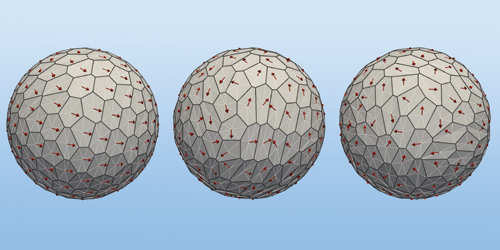Emergent Chirality in Active Rotation
In the earliest stages of an animal’s life, a blob of dividing cells gradually gains structure and the ability to move. Interactions among the cells play a role in that transformation, as does symmetry breaking. Now Tzer Han Tan of the Max Planck Institute for the Physics of Complex Systems in Germany and his colleagues have studied how the combination of cell–cell interactions and symmetry breaking plays out in a model system. Specifically, they have discovered how microspheres made of mouse pancreas cells are able to rotate by themselves [1].
Tan and his collaborators embedded cells that multiplied into spheres in a synthetic extracellular matrix and recorded video of them for up to 15 hours. Most of the spheres rotated as if they were solid bodies. Some rotated and stopped. Others did not rotate at all, but their surfaces flowed like a fluid. What’s more, the cells elongated and aligned in patterns that broke chiral symmetry.
To investigate this behavior, the team developed a model that rendered the cells as abutting pentagons and hexagons on a sphere’s surface. The polygons’ shared vertices could move in response to forces the polygons exerted on themselves and on the surrounding matrix. The model’s built-in propensity for the forces from neighboring polygons to align, together with the introduction of noise, could account for the various rotational behaviors. The directions of these forces were represented in the model by a polarity field, which inevitably contained topological defects. A corresponding model that treated the surface as a continuum revealed that these defects caused the symmetry breaking observed in the recordings.
Gel-embedded pancreatic-cell spheres might seem unnatural. However, tissue rotation has been observed in fruit flies and may also be relevant to collective movements in the context of a tubular organization in the pancreas. Tan and his colleagues say their work shows how symmetry-breaking processes in living active matter can be induced by the interplay of geometry, topology, and collective dynamics.
–Charles Day
Charles Day is a Senior Editor for Physics Magazine.
References
- T. H. Tan et al., “Emergent chirality in active solid rotation of pancreas spheres,” PRX Life 2, 033006 (2024).




